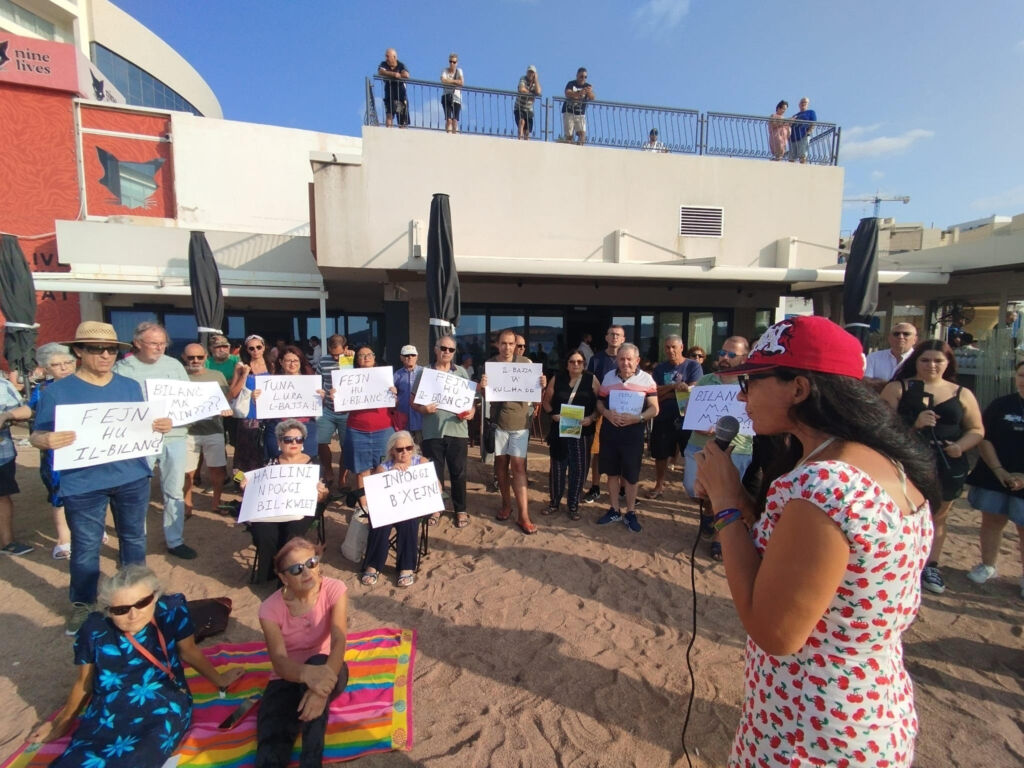St Paul’s Bay Residents Demand Rights To ‘Perched Beach’ Seashore In Latest Protest

St Paul’s Bay residents, supported by a coalition of resident groups, recently descended onto ‘Perched Beach’ in St Paul’s Bay, demanding their rights to a free and unencumbered seashore.
The latest protest happened on 15th September, where Residenti San Pawl il-Baħar were supported by Għaqda Residenti Slimiżi, Residenti Beltin, Marsaskala Residents Network, Azzjoni Tuna Artna Lura, Residenti Melliħin, Marsaxlokk Heritage Group, as well as Moviment Graffitti and Flimkien Għal Ambjent Aħjar, to protest their right to the seashore.
In a statement, Flimkien Għal Ambjent Aħjar explained how back in 2006, the perched beach had cost LM 456,516, for the structure to be built and filled with artificial sand. The original rocky beach was transformed into a 2,000 square-metre sandy beach, raised above sea level and equipped with bridges and ladders.
“However, since 2006, two-thirds of this public beach have been seized by tourism operators, reducing the public area to only a third of the beach, while one third is occupied by Amazonia and the other by DB Group,” the statement said.
Fast forward to 2017, the Planning Authority had approved Silvio Debono’s (DB Group) project for a new beach lido to be built on the beach, and excavate a tunnel linking it to the San Antonio Hotel.
“This year the PA also legalised DB’s internal and external alterations, beach furniture and bar on the beach, while DB’s sun beds have completely taken over the public’s stretch of land by the seashore.”
“The Dolmen Hotel’s plans to build two kiosks on top of two pool deck levels and two restaurants along the Buġibba promenade are set for approval. The new structures will replace the current Amazonia lido which also occupies the public beach between the Dolmen Hotel and Buġibba’s beach which it also encroaches.”
This project, approved despite strong objections by the St Paul’s Bay Local Council, increases the built-up area on the perched beach from 74 to 113 square metres, narrowing the existing public passageway.
“In addition to the original €1.6 million of public funds spent to build this perched beach, this year, the MTA announced that over €900,000 were spent to replenish St George’s Bay in St Julians and the Buġibba beach with artificial sand. Yet fully two-thirds of this beach, paid for and maintained by the taxpayers, has been given over to business barons, DB’s Amazonia Lido, Nine Lives, and the Tumas Group’s Dolmen Hotel, leaving the public packed on the remaining one-third.”

“This is far from the ‘balance’ that the government has been promising citizens. This perched beach is funded by the public for the public and not for private use.”
Now, St Paul’s Bay residents are arguing that they are being deprived of swimming facilities at the Għar tal-Veċċja, due to its dangerous state.
A year ago, the residents had come to an agreement with Stefan Zrinzo Azzopardi, Parliamentary Secretary for Planning, that boulders would be placed opposite the cave to mitigate wave damage, while two concrete stairs with platforms would be built to provide access to the sea.
However, fresh plans were submitted without such access on the pretext of safety, when the most unsafe area is still accessible and frequented by youths jumping from on top of the unstable cave in Triq Stella Maris.
“Residents are understandably angry that their solution to create accessibility to the sea whilst blocking the unsafe zone has been ignored by the authorities, leaving them without swimming facilities while exposing the public to danger in an area that has already seen serious accidents due to rock falls.”
Protestors also noted how Malta has the highest population density in Europe and the lowest percentage of area for public recreation.
The local protestors, supported by other residents’ groups, maintained that the “takeover of the seashore in order to enrich tourism operators, and the arrogance in ignoring residents’ rights are environmental injustices that are seriously undermining residents’ physical and mental health, as well as quality of life”.
What do you make of this protest?
